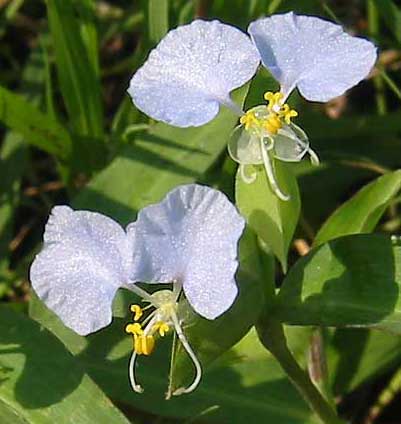Excerpts from Jim Conrad's
Naturalist Newsletter
from the May 5, 2008 Newsletter written in the community of 28 de Junio, in the Central Valley 8 kms west of Pujiltic, elev. ~700m (2300ft), ~N16.331°, ~W92.472°; southeastern Chiapas state, MÉXICO
DAYFLOWERS FLOWERING
In the grassy middle of the trail leading among cornfields smelling of chemicals there was a delicate- looking little wildflower surviving as contentedly as if it were at a forest edge up in Kentucky. It was a dayflower, genus COMMELINA, of the Spiderwort Family. Dayflowers are monocots like grass and lilies, not dicots like roses and asters. You can see the flowers below:

About 170 dayflower species, or members of the genus Commelina, are recognized. They're all herbs and they're found worldwide. In Chiapas we have maybe ten species.
As you can see in the picture, a distinguishing feature of dayflowers is that they typically bear two large, clawed (on a stem) petals above a collection of stringy, hard-to-interpret items in the blossom's center. Each flower actually has three petals, just that the lower one is much reduced and seldom noticed.
Each flower also bears six stamens, of which only three produce pollen. The other three are staminodia, or sterile, modified stamens. In the picture you can see in the center of each flower some yellow, star-shaped items. Those are the staminodia. I'm guessing that with their bright yellowness they help attract pollinators to the blossoms' centers, and maybe provide something for the pollinators to hold on to as they probe for nectar down below.
Plantas Medicinales de Mexico is effusive about applications of dayflower leaves and stems staunching bleeding, whether from cuts, amputations, or bloody noses or hemorrhoids. Also dayflowers have been used to lessen the sharp pains of childbirth.